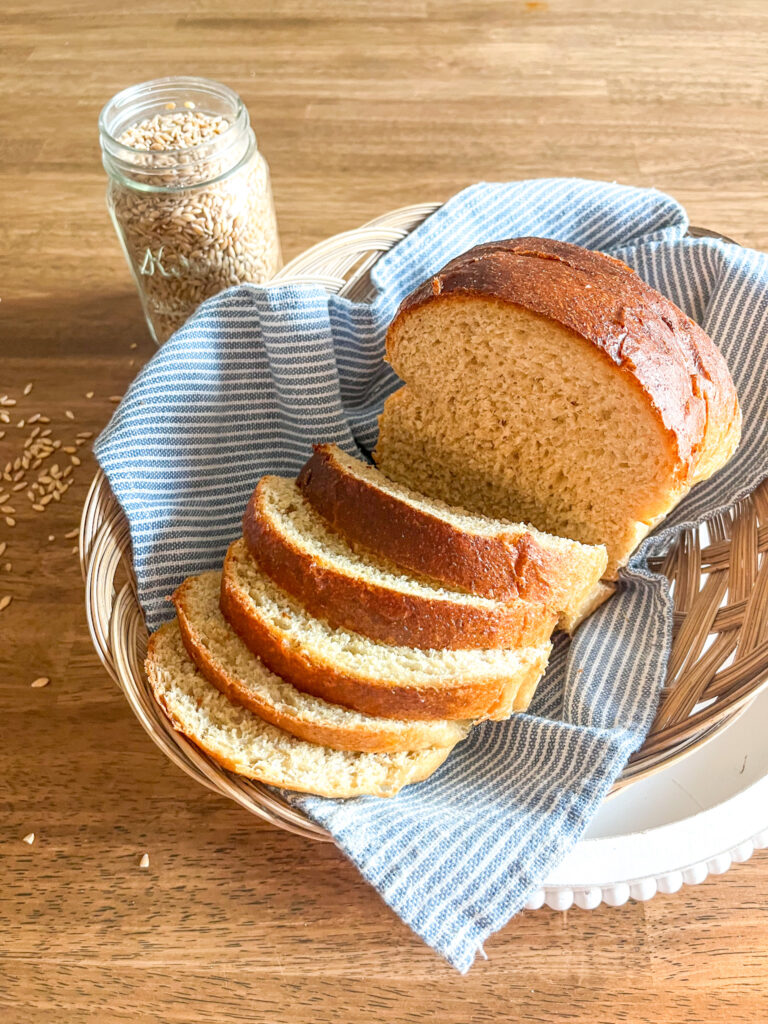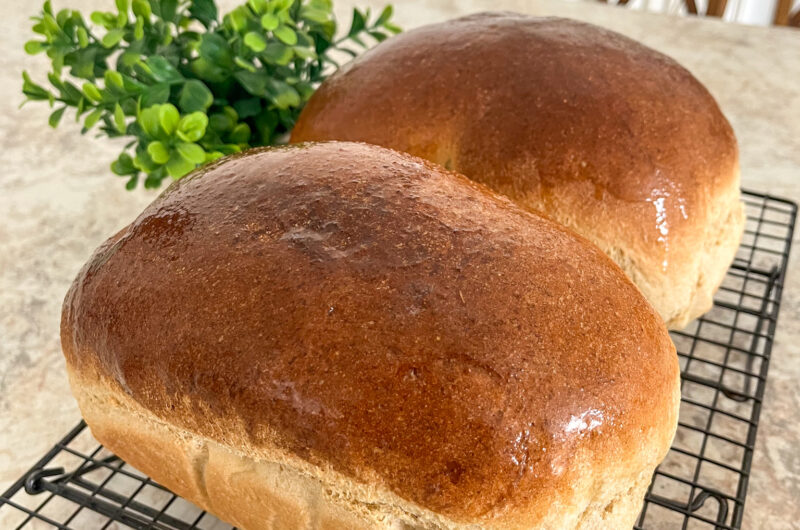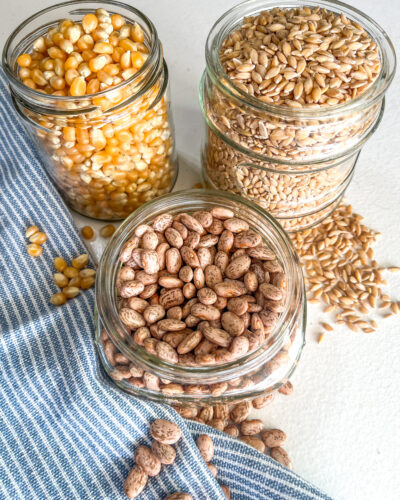
My mom taught me how to bake when I was twelve, so I’ve been baking for a long time. Shortly after I was married, I learned about the health benefits of freshly milled wheat flour. As a result, I purchased an electric grain mill to make my own flour. That mill has been going strong for almost 16 years, so the investment was well worth the benefits it has brought to me and my family.
History of Wheat
Ancient Wheat
Wheat has been grown by humans for thousands of years. The ancient Sumerians that lived in Mesopotamia grew wheat and other crops. Also, archaeological evidence has been found of the Egyptians milling wheat, baking bread in ovens, and developing a food production system. The wheat used in ancient times was Emmer and Einkorn.
Modern Wheat
Modern wheat has been hybridized to make it easier to harvest. Emmer and Einkorn are hulled grains that are difficult to thresh. Modern wheat is free threshing. The naked grain inside the wheat berry is released during the threshing process. As a result of hybridization, modern wheat’s gluten composition is different from that of ancient wheat such as Einkorn. For this reason, some people sensitive to gluten can tolerate Einkorn flour just fine. You can purchase Einkorn berries and flour online.
What are the Health Benefits of Freshly Milled Wheat Flour?
B Vitamins
Wheat is a very nutritious food. It contains the following vitamins: thiamin (B1), riboflavin (B2), niacin (B3), pantothenic acid (B4), biotin (B7), folate (B9), and vitamin E.
B vitamins assist our metabolism by breaking down our food to create energy. They also keep our brain cells, skin cells, and other tissues in the body healthy.
Vitamin E is an important antioxidant. It helps the body fight against cancer, oxidative stress, cataracts, atherosclerosis, and Alzheimer’s disease.
Minerals
Wheat is high in the following minerals:
- Copper- helps your cells create energy and protects you from free radicals.
- Magnesium- helps your body use protein, helps your nerves and muscles to work properly, controls your blood glucose, and regulates blood pressure.
- Zinc- helps with enzyme function, boosts the immune system, speeds healing, and promotes cell health.
- Phosphorus – is a part of our teeth, bones, DNA, and RNA. It is crucial to our cell membrane’s structure and in creating our body’s energy source, ATP.
- Iron- is needed to make red blood cells that move oxygen from the lungs to body tissue. It helps our muscles convert food into energy, our body to grow, our nervous system to develop properly, our cells to function, and our hormones to work.
Protein
Wheat contains the following proteins:
- Gluten and gliadin- help bread dough maintain elasticity and the ability to rise. Those with celiac disease must avoid these proteins because their immune system attacks them. For those who can tolerate it, gluten feeds the good bacteria in your body.
- Albumin- helps plasma to stay in your blood vessels and carries hormones, vitamins, and enzymes throughout the body.
- Globulin – helps your liver and kidneys work properly and your blood to clot. It also prevents infections.
Fiber
Eating enough fiber is important because it keeps the digestive system functioning as it should. Not only is it crucial for digestive health, but it is also a huge factor in our energy levels and heart health because it cleans out the arteries. Fiber feeds the good bacteria in our gut. When we have a healthy gut, it helps our central nervous system operate properly.
Different Types of Flour
Refined Flour
Wheat berries are made of three parts: bran, germ, and endosperm. In refined flour, the bran and germ are removed so the flour stays fresh for a long time. As a result, all-purpose flour is low in nutrients because most nutrients are stored in the bran and germ. Major minerals can be lowered up to 72% and trace minerals up to 64%.
Also, many refined flours are bleached. I wouldn’t eat bleach, so why would I eat flour that has been bleached?
Whole Wheat Flour
Wheat flour from the store has more nutrients. However, once a wheat berry is ground into flour, the fatty acids inside oxidize. It is recommended to store whole wheat flour for only two weeks. Also, when the B vitamins in wheat are exposed to light and air through the milling process, they break down.
Many whole wheat flours and products contain preservatives, so they do not go rancid due to oxidation. Preservatives are another chemical I do not want to eat.
Freshly Milled Whole Wheat Flour
Milling wheat berries at home is the best choice. This way you can be sure you are getting the most nutrients. I highly recommend buying organic wheat berries that do not contain glyphosate. Wheat berries store for a very long time. When I mill wheat berries for a recipe, I store the leftover flour in the freezer. This way I can pull it out and use it the next time I want to bake. You can buy an electric grain mill and organic wheat berries on Amazon or other websites and have them shipped to your door. Here is a brand I like on Amazon: Grand Teton- 100% Hard White Wheat Berries. This is the brand I like for soft white wheat berries: Findlay’s Organics Soft White Wheat Berries.
How to Start Using Freshly Milled Wheat Flour
Grinding the Berries
I buy organic hard white wheat berries in bulk and store them in 5-gallon food-grade buckets. When I want to make bread, I simply mill a large bowl of hard white wheat berries in my electric grain mill and use the flour. Hard white wheat berries are better for yeast recipes, like bread and rolls. Soft white wheat berries are better for quick breads, cakes, cookies, and pie crusts.
Baking Bread
Whole wheat bread made completely with freshly milled flour tastes different than regular store-bought bread. The texture can also be dense and crumbly. I want to make healthy bread for my family, but I also want everyone to like and eat it. As a result, I make my bread with half organic all-purpose flour and half freshly milled wheat flour. This way we receive nutrients from the whole wheat flour, but the bread still has a fluffy, soft texture we all enjoy. Once you get the hang of it, making bread is an enjoyable process that requires very little hands-on time. Plus, the smell of freshly baked homemade bread is heavenly. Here is the recipe for the whole wheat bread pictured at the top of this post.
Whole Wheat Bread
Difficulty: Easy1
loaf30
minutesThis delicious whole wheat bread is made with a mix of freshly milled wheat flour and all-purpose flour.
Ingredients
1 cup warm water
2 1/4 teaspoons yeast
1tablespoon plus 1teaspoon olive oil
1teaspoon salt
1/4 cup brown sugar
1 1/2 cups freshly milled whole
wheat flour1 1/2 cups all purpose flour
Directions
- Combine warm water and yeast with whisk. Let sit five minutes.
- Add olive oil, salt, brown sugar, and mix using paddle attachment on your stand mixer.
- Add freshly milled whole wheat flour and mix in.
- Gradually stir in the all-purpose flour to form a soft dough. Knead 6 to 8 minutes by hand
or with the dough hooks for your stand mixer. - Place in greased bowl. Cover and let rise one hour.
- Grease loaf pan or line with parchment paper. Roll dough into a loaf and place in pan.
Cover and let rise one hour. - Bake at 350 degrees for 30 minutes or until lightly browned. Brush top with melted butter.
Also, I created a free PDF called “Baking with Wheat Flour”. It includes recipes for whole wheat bread and dinner rolls that are easy to print out. Please subscribe to the bi-weekly newsletter to receive this free resource!



